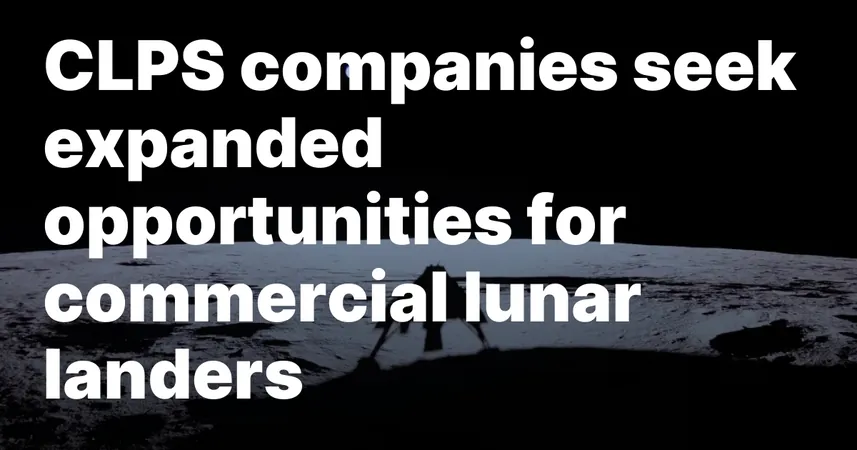
Lunar Lander Companies Push for Better Opportunities as Concerns Rise Over VIPER Mission
2025-04-02
Author: Arjun
Lunar Lander Companies Push for Better Opportunities as Concerns Rise Over VIPER Mission
In a pivotal moment for lunar exploration, lander companies are urging NASA to reconsider its current strategy for procuring lunar landing services as lawmakers express growing concerns regarding a significant lunar rover mission. This development comes on the heels of a House Science Committee hearing on April 1, where executives from key players in NASA's Commercial Lunar Payload Services (CLPS) program made their case for substantial changes.
During the hearing, Jason Kim, CEO of Firefly Aerospace, highlighted the CLPS model as a major factor in his company’s recent success with the Blue Ghost 1 lander, which successfully touched down on the moon just a month prior. He stressed the need for 'stable, multi-year funding commitments' from NASA to support a reliable schedule of two to three missions annually while advocating for investments in facilities for equipment testing and improved communications systems. This call for financial stability aims to enhance the entire supply chain involved in lunar mission logistics.
Meanwhile, companies are looking to the future with the impending rollout of a second phase of the CLPS initiative, referred to as CLPS 2.0, which is set to occur once existing contracts expire in 2028. John Thornton, the CEO of Astrobotic, whose Peregrine lander recently faced a propulsion failure shortly after its January 2024 launch, advised that NASA consider purchasing these landers in bulk from companies engaged in CLPS operations. He argued this approach would foster cost savings and strengthen the U.S. supply chain for lunar missions.
In agreement, Steve Altemus, president and CEO of Intuitive Machines, proposed that CLPS should broaden its scope to facilitate the delivery of not only landers but also essential lunar infrastructure. He suggested that if NASA expands contracts to involve multiple governmental agencies, particularly those focused on national security, it could drive efficiencies, reduce expenses, and promote collaborative innovation.
As these companies advocate for an evolved CLPS, concerns about NASA's management of the VIPER (Volatiles Investigating Polar Exploration Rover) mission loom large. The committee expressed discontent following NASA's July announcement to cancel VIPER, which was set to use Astrobotic's Griffin lander. Instead, NASA has offered the rover to private companies willing to cover the costs for a lunar flight, raising skepticism among experts about the feasibility of executing vital scientific objectives without the agency's direct support.
Prominent lunar scientist Brett Denevi cautioned during the hearing that relying on potential private partnerships to support VIPER’s mission was not a viable strategy, warning that without legislative intervention, the U.S. could lose its initial edge in lunar exploration efforts, particularly as other nations, like China, are poised to conduct their own exploration missions.
In defense of the decision, Nicky Fox, NASA's Associate Administrator for Science, reiterated that financial constraints necessitated the cancellation of VIPER to ensure future CLPS missions weren't adversely affected. However, her comments did not quell concerns among committee members, including Rep. Zoe Lofgren, who expressed dissatisfaction with the explanations provided regarding the implications of VIPER's termination.
With the future of lunar exploration now hanging in the balance, experts and industry leaders emphasize the importance of a cohesive strategy that not only ensures funding for ongoing missions but also leverages the competitive landscape of private space exploration to accelerate advancements in lunar science and technology. As this dialogue continues, the efforts of CLPS companies to adapt and provide innovative solutions for space exploration may ultimately shape the direction of humanity’s return to the moon.

 Brasil (PT)
Brasil (PT)
 Canada (EN)
Canada (EN)
 Chile (ES)
Chile (ES)
 Česko (CS)
Česko (CS)
 대한민국 (KO)
대한민국 (KO)
 España (ES)
España (ES)
 France (FR)
France (FR)
 Hong Kong (EN)
Hong Kong (EN)
 Italia (IT)
Italia (IT)
 日本 (JA)
日本 (JA)
 Magyarország (HU)
Magyarország (HU)
 Norge (NO)
Norge (NO)
 Polska (PL)
Polska (PL)
 Schweiz (DE)
Schweiz (DE)
 Singapore (EN)
Singapore (EN)
 Sverige (SV)
Sverige (SV)
 Suomi (FI)
Suomi (FI)
 Türkiye (TR)
Türkiye (TR)
 الإمارات العربية المتحدة (AR)
الإمارات العربية المتحدة (AR)